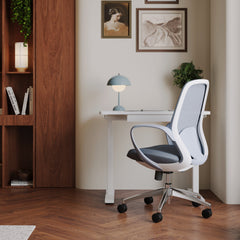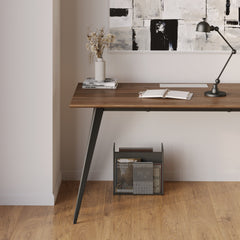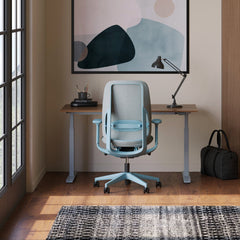Get 10% off your first order
Find the office furniture that’s designed to match your style, comfort, and needs perfectly. Subscribe
Workstations That Evolve with Your Schedule

Visit quiz page to see how we makes it easy to create an inspiring workplace

Modern office chairs have moved far beyond the role of basic seating. They now integrate adaptable mechanics, inclusive ergonomics, sustainable materials, and discreet technology to support real bodies in real work. Progress in this category is less about flashy gadgets and more about subtle, evidence-informed refinements that encourage healthy posture, reduce strain, and harmonize with hybrid work environments. The most useful innovations are those that translate design theory into daily comfort and reliable performance.
Early task chairs prioritized durability over human movement. Contemporary designs recognize that prolonged stillness increases musculoskeletal stress, so the frame, back, and seat now work together to invite posture variation. Chairs that exemplify micro-mobility encourage small shifts in pelvis, shoulders, and hips, which helps maintain circulation and spinal nutrition during long sessions.
A strong example of motion-forward engineering appears in advanced ergonomic performance seating, where tension, recline ratio, and seat angle collaborate to keep the user supported without feeling locked in place. The objective is not perpetual rocking, but measured responsiveness that helps users transition between focus, collaboration, and reflection with minimal strain.
Not all recline systems feel the same, even when they share the same marketing terms. The ergonomics of a chair depend on the relationship between seat pan angle, backrest pivot, and lumbar contour. The following table summarizes the practical differences many users feel day to day.
| Mechanism | What Moves | Practical Feel | Best For |
|---|---|---|---|
| Center Tilt | Seat and back pivot from a central point | Simple rocking, knees may rise | Short seated tasks, conference rooms |
| Synchro Tilt | Back reclines more than the seat in a set ratio | Maintains pelvic angle, keeps feet grounded | General knowledge work with frequent posture changes |
| Weight-Sensitive | Auto-adjusts tilt tension to body mass | Seamless transitions, fewer knobs to set | Shared workstations, hot desking |
| Asynchronous | Independent controls for back and seat | Fine-tuned posture, learning curve | Users who want granular adjustments |
| Adaptive Motion | Micro-flex in frame, back, and seat | Subtle movement without disengaging focus | Long seated sessions that still demand mobility |

Many new chairs focus on smart simplicity. The goal is to reduce the adjustment burden while retaining personalization. Weight-responsive recline, multi-zone mesh tensions, and shaped foams provide support that feels custom without a complex setup. When a chair is intuitive, workers are more likely to use it correctly.
Precision back geometry makes the difference between a chair that feels pleasant for an hour and one that feels supportive all day. Consider the way targeted lumbar zones and breathable back structures in ergonomic spine-alignment support technology maintain the natural lumbar curve while allowing shoulder blades to glide freely. Balanced resistance helps the user settle into neutral posture rather than fighting the chair.
Even with weight-responsive systems, targeted controls still matter. Seat depth helps distribute load along the thighs, which is vital for taller or shorter users. Armrest height and pivot reduce shoulder elevation and wrist deviation during typing. Back height and lumbar sliders let users match support to their spinal landmarks. These small dials often produce the largest long-term gains.
For foundational guidance that aligns with occupational health practice, the CDC’s Ergonomics Guidelines for workplace posture outline neutral joint positions, monitor alignment, and the importance of movement breaks. Chairs should make these recommendations easier to follow rather than turning them into a chore.
Ergonomics is not only about joints and muscles. Texture, breathability, and acoustic softness influence how people feel and perform. A cushion that regulates microclimate, a fabric that avoids cling, and a frame that minimizes squeaks can reduce subtle distractions that accumulate during long work hours. This is the essence of neuroergonomics, where sensory design supports cognitive flow.
Sustainability in seating design focuses on resource selection, production methods, and long-term serviceability. Recycled aluminum frames, bio-based foams, and water-borne finishes help reduce chemical emissions and environmental impact. Minimal part counts and fastener-based assembly reduce adhesive use while making service easier.
The principles show up in products like the eco-conscious minimalist seating design, where a focused material palette and efficient geometry deliver comfort without excess. The goal is not to chase novelty for novelty’s sake, but to achieve comfort, durability, and repairability with fewer inputs.
Breathable meshes and performance textiles have evolved toward tighter weaves for support with sufficient airflow. Many mills now offer recycled content fibers, solution-dyed yarns that use less water, and topcoats with reduced volatile organic compounds. Foams derived partly from plant oils offer resilient support while reducing reliance on petroleum sources.
| Material or Process | What It Contributes | Why Users Care |
|---|---|---|
| Recycled Metals | Structural strength with lower footprint | Durable frames that can be reprocessed |
| Plant-Derived Foams | Responsive cushioning with partial renewable content | Comfortable support with reduced emissions |
| Water-Borne Finishes | Lower VOCs compared to many solvent systems | Better indoor air quality and odor control |
| Modular Parts | Replace components instead of whole chairs | Lower long-term cost of ownership and less waste |
A chair that lasts longer is better for the planet. Design that allows the swap of casters, arms, cylinders, and textiles reduces landfill volume and keeps comfortable chairs in service. Clear part labeling, accessible fasteners, and standard hardware sizes make repairs straightforward for facilities teams.
Hybrid work has turned many homes into professional studios. Seating needs to perform like contract-grade equipment while fitting into living spaces. The most successful designs treat the chair as an architectural element, where silhouette, proportion, and light interplay matter as much as ergonomic performance. Pieces like the contemporary sculpted office chair design demonstrate how a fluid shell and tapered base can deliver posture support while complementing residential textures and color stories.
Workstations feel cohesive when chair finishes relate to desk materials. Warm woods pair with matte blacks and graphite meshes, while light oak complements softer neutrals. Matching radii between desktops and arm caps, or echoing a metal accent in the chair base, reinforces an intentional visual language. Integrated examples of ergonomic workspace solutions show how proportion and color coordination can enhance comfort by reducing visual noise.
Color psychology suggests that softly desaturated hues help sustain attention, while modest contrast can cue transitions between work modes. Tactile weaves with subtle sheen create depth without glare. Thoughtful texture selection supports visual calm, which can indirectly reduce muscle tension around the neck and shoulders.
Smart seating is most helpful when it offers gentle guidance rather than constant alerts. Pressure mapping and seated-time prompts can encourage breaks or pose a suggestion to adjust recline tension. Data should stay local or anonymized wherever possible. The aim is to nudge healthier habits, not to surveil individuals.
Some ecosystems pair chairs with apps that display neutral posture guidance. Short, actionable cues are more effective than complex dashboards. The variety within the adaptive seating innovations catalog illustrates how manufacturers interpret this balance, from purely mechanical solutions to chairs that optionally connect to broader wellness programs.
Motorized lift in seating remains rare, yet energy-conscious actuators appear in certain furniture categories. Where powered assistance exists, efficiency and quiet operation matter far more than speed. The most practical implementations support smooth, predictable changes that minimize distraction.
Advantages of gentle, efficient adjustment systems
Reliable transitions between active and relaxed postures
Consistent feel across shared benches or team areas
Lower acoustic footprint that preserves focus

An ergonomic chair cannot compensate for a poorly positioned work surface. The height of the desk influences elbow angle and wrist posture, and the display height sets neck position. Good pairings allow users to maintain a neutral spine while keeping feet supported. Flexible stations like height-adjustable desk systems make it easier to fine-tune these relationships for different tasks.
Rather than chasing perfection through endless tinkering, follow a simple order of operations. Adjusting in this sequence tends to produce a comfortable baseline that most users can maintain.
1. Set desk height so elbows rest near a right angle when typing.
2. Place feet flat, then raise or lower chair until thighs are level, add a footrest if needed.
3. Slide seat depth so there is about two to three fingers of space behind the knees.
4. Position lumbar support to meet the natural curve of the lower back.
5. Raise the screen so the top line of text is near eye level.
6. Bring armrests to a height that supports forearms without shrugging shoulders.
7. Test a few recline tensions until transitions feel smooth and controlled.
Even the best fitting setup benefits from variability. Shift posture every half hour, stand for brief calls, and alternate between focused forward-leaning work and supported recline. Short microbreaks for the shoulders and hips can do more than large, infrequent adjustments.
Bodies vary in height, mass, hip width, and spine shape. A chair that suits one person may cause pressure points for another. Inclusive models treat adjustability ranges as essential rather than optional. Seat depth options, multiple cylinder heights, and wider arm spans help welcome more users into neutral posture.
Coding, sketching, editing, and phone-heavy roles each place different demands on the upper body. Arms that pivot and slide support narrow typing stance for compact keyboards, then widen for a mouse-intensive workflow. The vertical range should meet the desk without forcing shoulders to lift.
Backrests that taper toward the top create clearance for shoulder blades during reach tasks. Pelvic support at the base prevents posterior tilt, which helps maintain the lumbar curve. Mesh backs distribute load evenly across the thoracic region while allowing heat to dissipate.
Mesh is not a single material. Performance depends on yarn composition, weave density, and how the fabric is tensioned over the frame. Balanced elasticity returns the user to center without hammock effect. Look for even tension fields that support lumbar contours without creating hard edges.
High resilience foam, sometimes layered with viscoelastic inserts, spreads load across the sit bones and upper thighs. Perforations or contour cuts can improve breathability. The top cover should glide just enough to let the pelvis reposition, yet still provide traction for stable typing posture.
Die-cast aluminum and reinforced polymers must balance stiffness with controlled flex. Excess rigidity can feel harsh, while too much give undermines precision. A well tuned frame behaves like a bridge, firm under load with subtle compliance that absorbs micro-movements.
In homes that double as studios, chairs often sit in open view. Forms with soft radii and muted finishes read as intentional design rather than afterthought equipment. With careful selection, the chair becomes a focal element that signals craft and care without stealing attention.
Compact rooms benefit from lighter visual weight, such as narrow back frames and translucent meshes. Larger rooms can accommodate sculptural shells or padded silhouettes. Collections that include matching tables and storage help maintain a cohesive story across the room.
Before committing, verify three core sensations. First, sit upright and type to test front-edge comfort. Second, recline to confirm you feel supported through the mid back and lumbar. Third, swivel and reach to check if the chair follows without tugging at the knees or hips.
Ask which parts are field replaceable, how textiles are attached, and whether cylinders and casters use standard fittings. Clarify availability of parts for several years and whether the brand provides clear documentation for facilities teams.
Match finish and scale to the room and to the desk. If your desktop is extra thick or thin, verify that arm height and clearance still allow neutral elbows. If you share a workstation, choose controls that multiple users can understand at a glance.
Organizations increasingly view seating within a constellation of furnishings that includes sit-stand tables, mobile storage, and acoustic elements. Collections that share design DNA make it easier to scale environments across floors and satellite spaces.
Use a three-part filter to narrow choices. First, confirm fit through seat depth, back shape, and arm range. Second, check motion through recline geometry and weight response. Third, align finishes and scale with the room and desk. If a model passes these filters, evaluate serviceability and environmental profile.
If you are upgrading both seating and desk, coordinate decisions so they enhance each other. Desk height range, base shape, and cable routing affect chair posture and movement. Integrating with complementary furniture such as ergonomic workspace solutions often leads to a cleaner, more stable setup.
Equipment should support the body, then step out of the way. Correctly set chair height, seat depth, and arm position matter more than advanced features that are rarely used. For teams that share stations, intuitive controls and clear visual cues lead to better adoption than dense menus or rarely consulted app screens.
Ergonomic innovation reflects not only technical progress but also cultural context. Climate, culture, and workspace customs shape comfort expectations worldwide. Warmer regions tend to favor ventilated meshes and breathable foams, while cooler climates prefer upholstered finishes that preserve warmth. Manufacturers adjust chair dimensions using local anthropometric data to ensure optimal fit for regional populations.
Localized production reduces carbon emissions and strengthens community economies. In North America, recycled aluminum frames and certified hardwoods dominate; European factories emphasize compact modular components; Asian suppliers integrate bamboo and plant-based foams; Middle Eastern producers explore temperature-regulating natural leather alternatives. Each approach blends geography with sustainability to serve the global shift toward eco-responsible comfort.
| Region | Material Focus | Notable Ergonomic Trend |
|---|---|---|
| North America | Certified woods, recycled alloys | Hybrid office integration and durability |
| Europe | Recyclable textiles, modular parts | Compact design for urban workspaces |
| Asia-Pacific | Bamboo, plant-based foams | Climate-adaptive breathability |
| Middle East | Natural leather alternatives | Temperature-regulating upholstery |
Designers increasingly address diversity in body size, gender, and mobility. Broader seat ranges, adjustable lumbar depths, and optional headrests cater to varied anthropometrics. Local research into sitting behaviors informs design tweaks that make chairs more inclusive across continents.
Global principles of posture safety, informed by occupational health studies, are now interpreted regionally to meet local regulations. Manufacturers that align international guidelines with national certification processes ensure both cultural relevance and ergonomic reliability.
As digital collaboration unites workers across borders, consistent comfort becomes a shared expectation. The modern office chair must succeed equally in a New York apartment, a Singapore studio, or a Scandinavian co-working space. True innovation arises when global design philosophies adapt seamlessly to local needs, fostering comfort that transcends geography while respecting diversity.
Feet supported on the floor or a footrest, thighs level
Seat depth adjusted to leave a small gap behind the knees
Lumbar support meeting the lower back rather than flattening it
Arm height raised until shoulders feel relaxed
Screen top near eye level, keyboard close to elbow height
Recline tension set so the back follows without sudden drop
Short breaks scheduled to stand, stretch, or walk
Shared workstations benefit from weight-responsive recline systems
Warm environments pair well with breathable mesh and airflow channels
Fine motor tasks benefit from adjustable 4D armrests
Hard flooring calls for soft casters or a suitable mat
Modern office chairs are now central to healthy, productive workspaces worldwide. Their evolution demonstrates that the most meaningful innovations emerge when comfort, sustainability, and inclusivity intersect. The office chair has become an intelligent partner—quietly supporting better posture, reducing fatigue, and adapting gracefully to the diverse ways people work and live.

Workstations That Evolve with Your Schedule

Spaces That Shift With You: Building a Workspace That Adapts to Every Task

Room to Think: Designing an Efficient Workspace Without Overcrowding
Get 10% off your first order
Find the office furniture that’s designed to match your style, comfort, and needs perfectly. Subscribe
Leave a comment